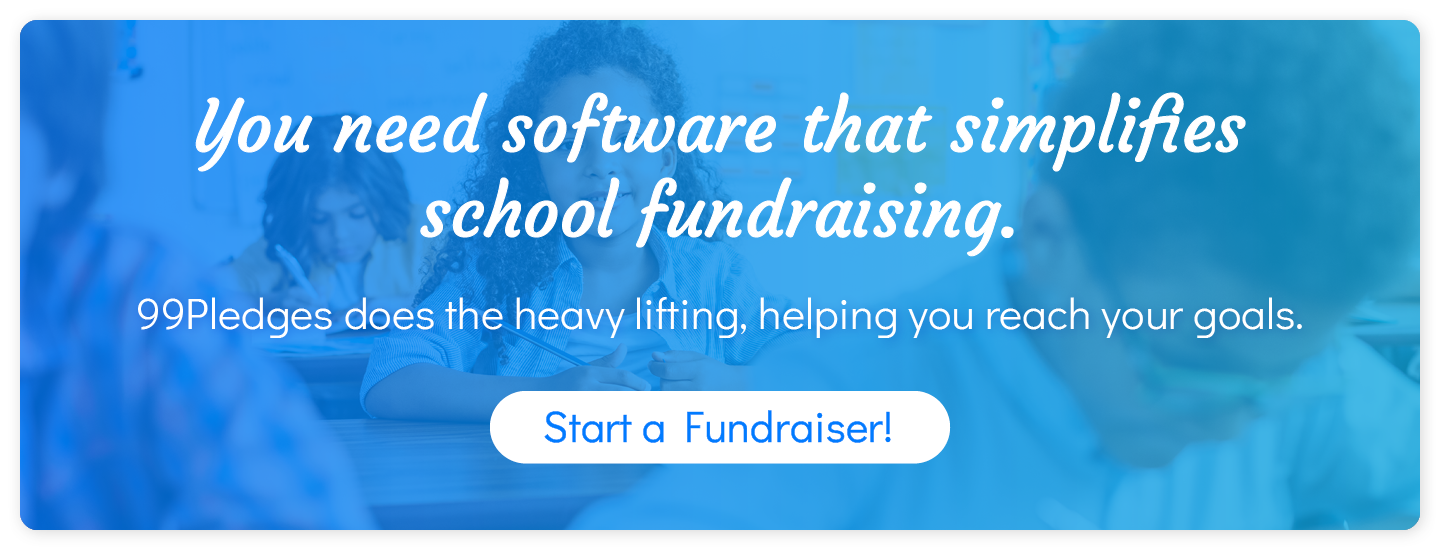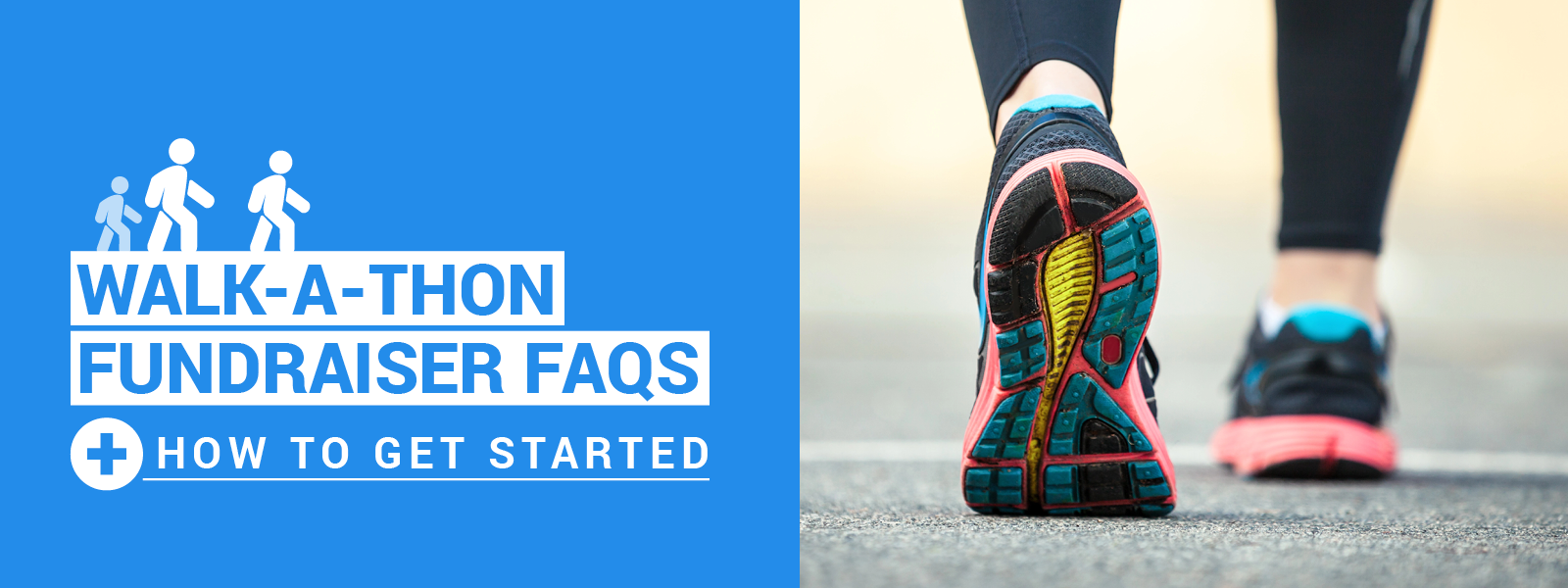
If your organization is searching for a fundraiser that’s easy to set up, inexpensive to host, and super effective, look no further than a Walk-a-thon! Walk-a-thons bring your community together, promote an active and healthy lifestyle, and can easily be connected to the cause you’re supporting.
To host an excellent Walk-a-thon, all you need is a designated area for participants to walk in, an effective outreach strategy to engage community members and supporters, and a way to gather donations.
In this guide, we’ll explore commonly asked questions about Walk-a-thons to help you start your own campaign. Here’s what we’ll cover:
- What is a Walk-a-thon?
- How does a Walk-a-thon fundraiser work?
- Which organizations can raise money with walk for a cause fundraisers?
- What is Walk-a-thon fundraising software?
- What are some essential software features for fundraising walks?
- What are some common Walk-a-thon pitfalls to avoid?
- How can you organize a Walk-a-thon?
What is a Walk-a-thon?
A Walk-a-thon, also known as a charity walk or walk for a cause, is a peer-to-peer fundraising event where participants collect pledges for donations based on how far they walk. Community members volunteer to raise funds on an organization’s behalf, walk a set distance, and then collect money for your cause. Donors might pledge to give $X for every mile or donate a flat amount after the event.
How does a Walk-a-thon fundraiser work?
In a Walk-a-thon, which is similar to a jog-a-thon or a fun run, participants gather donations by encouraging their peers and family members to pledge a fixed amount for each unit of distance they walk. For instance, a participant may receive a pledge of $5 per mile. If they walk three miles, they’ll receive $15 for your organization from each donor.
While the specifics of your charity walk might vary, the general process involves four standard steps:
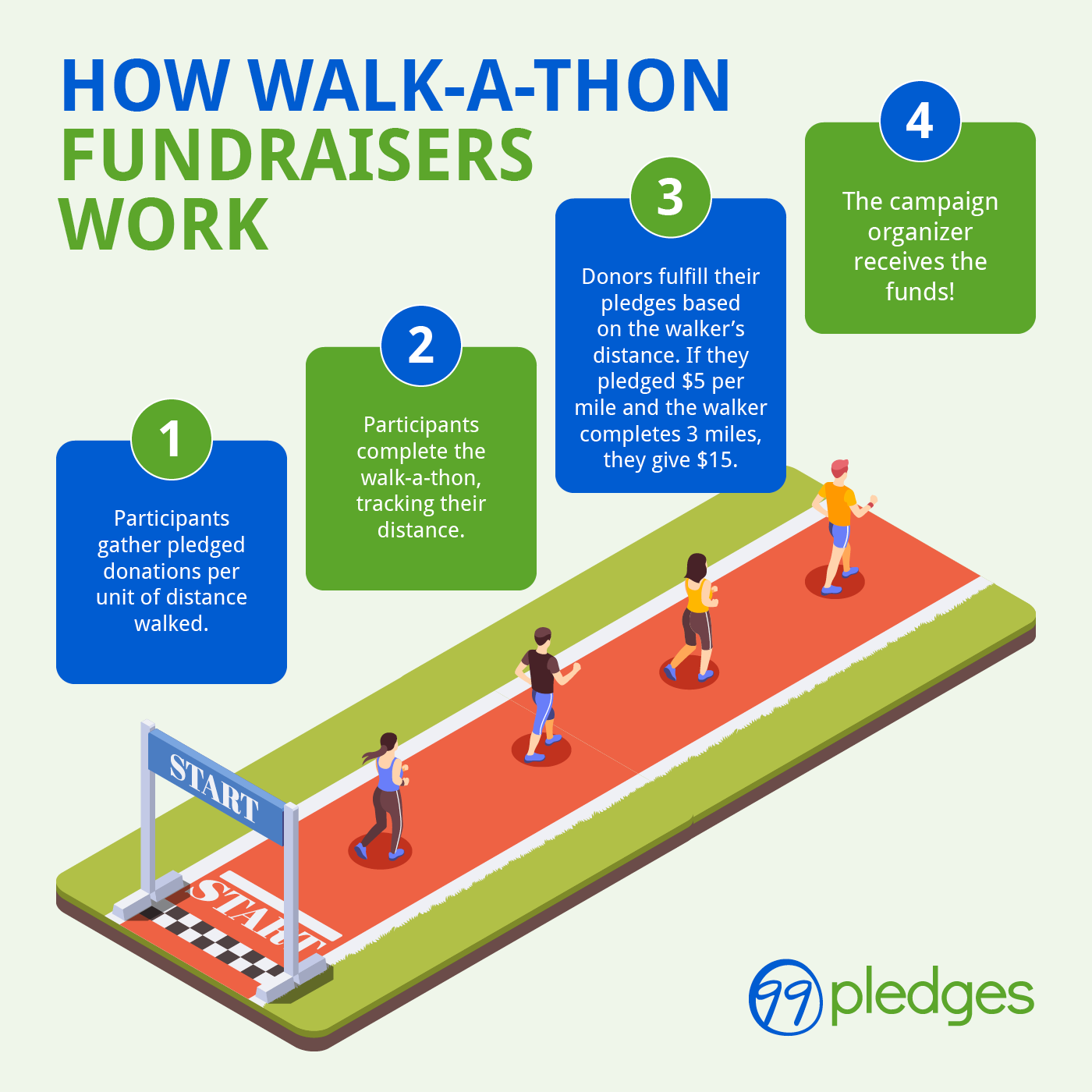
- Participants gather pledged donations per unit of distance walked. Participants use pledge fundraising software or paper forms to reach out to their peers and family members and ask for pledges. With the organizer’s help, they should contact as many potential donors as possible and provide plenty of detailed information about how funding will be used.
- Participants complete the Walk-a-thon, tracking their distance. All participants walk at a community event, getting some exercise and a chance to bond with fellow participants. Use mile markers, phones, or fitness trackers to calculate the total distance each person walks.
- Donors fulfill their pledges based on the walker’s distance. Most pledges will be per-lap or per-mile donations to one or more walkathon participants. The total distance that the participants walk determines the size of their final gift.
- The campaign organizer receives the funds! All funding from pledges goes directly to your organization after the event.
Walk-a-thons are community events in which everyone has an important role to play. A successful Walk-a-thon depends upon the active participation and enthusiasm of organizers, participants, and community members. When everyone works together, you’ll host a fun, successful event that raises the funds your organization needs!
Which organizations can raise money with walk for a cause fundraisers?
Any organization can launch a walk for a cause event! Beyond nonprofits, organizers of various student and youth groups find the Walk-a-thon an easy yet fun and effective fundraising idea that kids of varying ages love to participate in.
Here are just a few examples of the types of organizations fundraising walks work for:
- Nonprofits: The American Cancer Society hosts regular Relay for Life events led by volunteers. These walkathons bring communities together to raise money for cancer research, advocacy, and patient support.
- Schools: Check out a sample page from Desert Christian Academy’s 47th annual Walk-a-thon! This PreK-12 school got students of all ages involved in the fundraising effort.
- Sports teams: The University of Pennsylvania’s football team hosted its third annual Walk-a-thon and raised over $6,000! All the money the team raises goes toward DIPG awareness and research in honor of a former player’s family member.
Walk-a-thons are especially perfect for schools, student clubs, church youth groups, sports teams, scout troops, and other kids’ groups. As participants, students take the lead in fundraising, connecting them with their organization’s goals and promoting teamwork, leadership skills, and dedication to a cause. As an added bonus, the Walk-a-thon event is a great opportunity to go outside and get moving with friends!
What is Walk-a-thon fundraising software?
Walk-a-thon fundraising software solutions are online platforms your organization can use to automatically generate shareable pages for each participant. Then, participants share the pages online with their friends, family, social media connections, and other supporters, who can easily make a pledge and donate.
Walk for a cause software pages are customizable so that participants can share important information about their club, school, or organization and the reason for the campaign with potential supporters. These solutions allow participants to reach a wider audience of supporters and offer the convenience of donating online, meaning your fundraising walks are likely to raise far more.
Some solutions can even give donors an estimate of the number of laps or miles a participant is likely to complete so they can quickly pledge an amount they’re comfortable with!
What are some essential software features for fundraising walks?
As the organizer of your Walk-a-thon, choosing the right software is an important part of your responsibilities. Some of the features you’ll want to look out for as you compare options include:
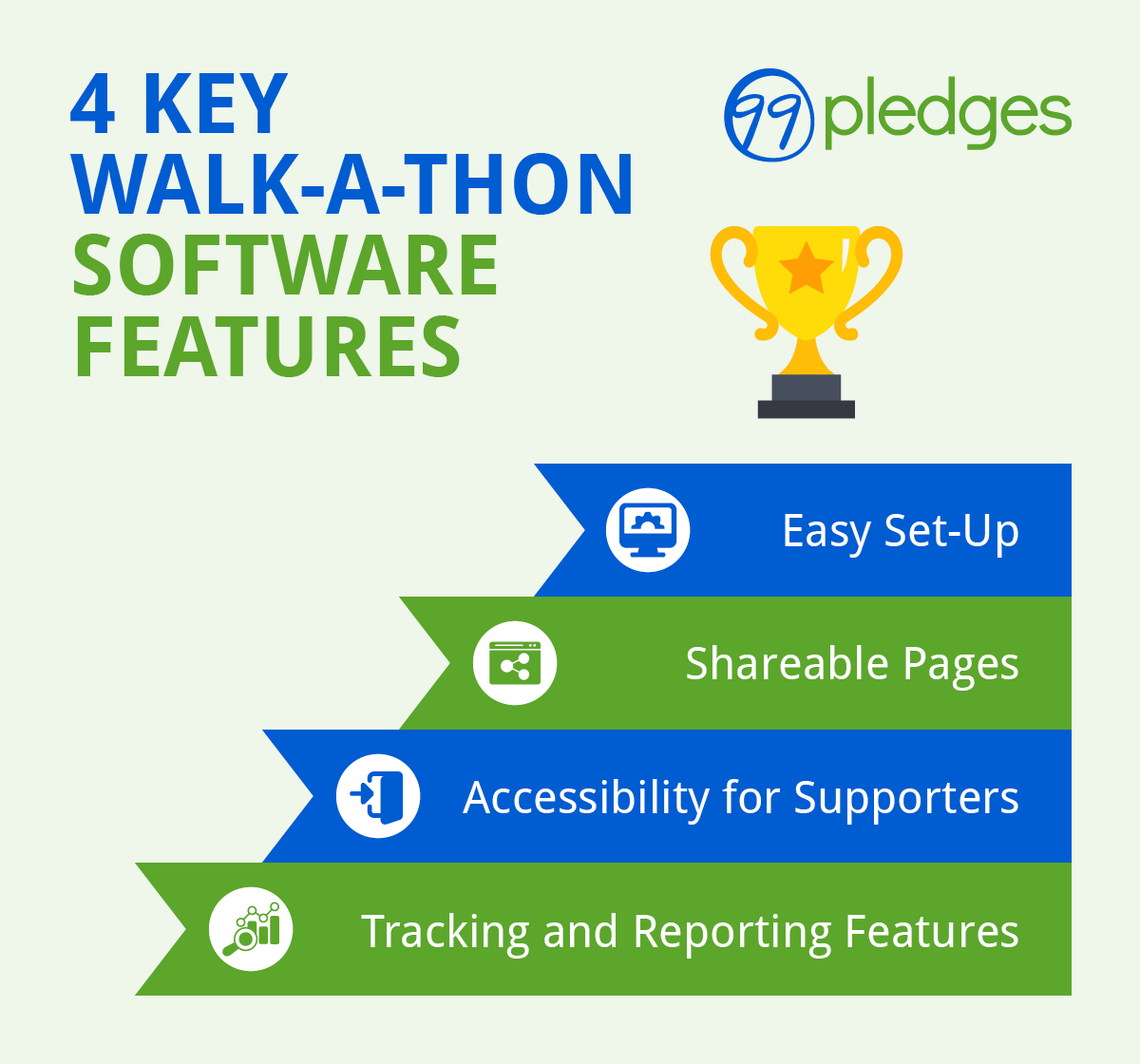
- Easy set-up. Whether parents take on the majority of the fundraising responsibility or older students can take the lead themselves, everyone must focus their efforts on sharing fundraising pages and collecting pledges. Choose a Walk-a-thon fundraising software provider that handles set-up for you so your pages are ready to go as soon as your student participants or their parents receive them.
- Shareable pages. The benefit of using online platforms for your fundraising walks is that participants can reach many more potential supporters. Look for software that allows you to share pages through as many marketing channels as possible, including text, email, and popular social media platforms.
- Accessibility for donors. Donors have varying giving preferences. If your Walk-a-thon fundraising software accepts more traditional cash and check donations in addition to credit cards and other convenient online payment methods, more supporters will find giving easy and convenient.
- Tracking and reporting features. It’s important that you know how your participants are doing as the pledge collection stage of your walk for a cause fundraiser progresses and how close you are to reaching your goal. Look for tracking and reporting features to help your team stay on track. You’ll also gain important insights, like donor behavior details and contact information, which you can use after the fundraiser.
Don’t forget to select any other tools or software you might need! For example, if the event is ticketed for the audience, invest in online registration software. Or, if you plan to boost the campaign’s impact by selling shirts or hats, you’ll need a peer-to-peer fundraising platform focused on custom merchandise.
What are some common Walk-a-thon pitfalls to avoid?
It’s natural to run into a few challenges when hosting fundraising walks, just like with any other large fundraising event. Luckily, staying aware of common pitfalls can help you avoid them and boost your chances of success.
In our experience, we’ve seen walkathon organizers make their lives more complicated by:
- Not having a clear goal. Set a concrete fundraising goal right at the beginning of your Walk-a-thon planning process to keep your team on track. Otherwise, you risk not allocating enough resources or recruiting enough participants to raise the money you need.
- Not promoting the campaign enough. Peer-to-peer fundraisers rely on widespread outreach. Without marketing your campaign far and wide (to both participants and potential donors), it won’t work. Make sure to create several marketing materials for your event and post them across communication channels to spread the word.
- Using a complicated fundraising process. Participating in your Walk-a-thon should be as quick, easy, and convenient as possible—that’s why choosing the right platform is so important! A simplified platform like 99Pledges will make it easy for participants and donors alike to turn your event into a success.
- Not creating a backup plan. Fundraising walks typically happen outside, and we all know that inclement weather can happen when we least expect it. Remember to create a backup plan, whether postponing the event to the next day or moving it inside to a large gym or athletic facility.
- Neglecting to recruit enough volunteers. Along with sufficient outreach, every peer-to-peer fundraiser relies on volunteers. Set goals early for the number of participants you want to recruit, and monitor your progress often to ensure you find enough.
If it seems a little overwhelming, don’t worry. Our comprehensive list of steps (coming up next!) will help you organize your Walk-a-thon seamlessly.
How can you organize a Walk-a-thon?
Your walk for a cause fundraiser begins with a specific, measurable goal and an enthusiastic team of participants. Beyond that, make the process of spreading awareness for your fundraiser and collecting pledges easy with software designed for Walk-a-thons. As mentioned, it’s best to choose software with shareable donation pages so participants can easily spread the word about their campaign online.
To get started with your own Walk-a-thon, follow these simple steps:
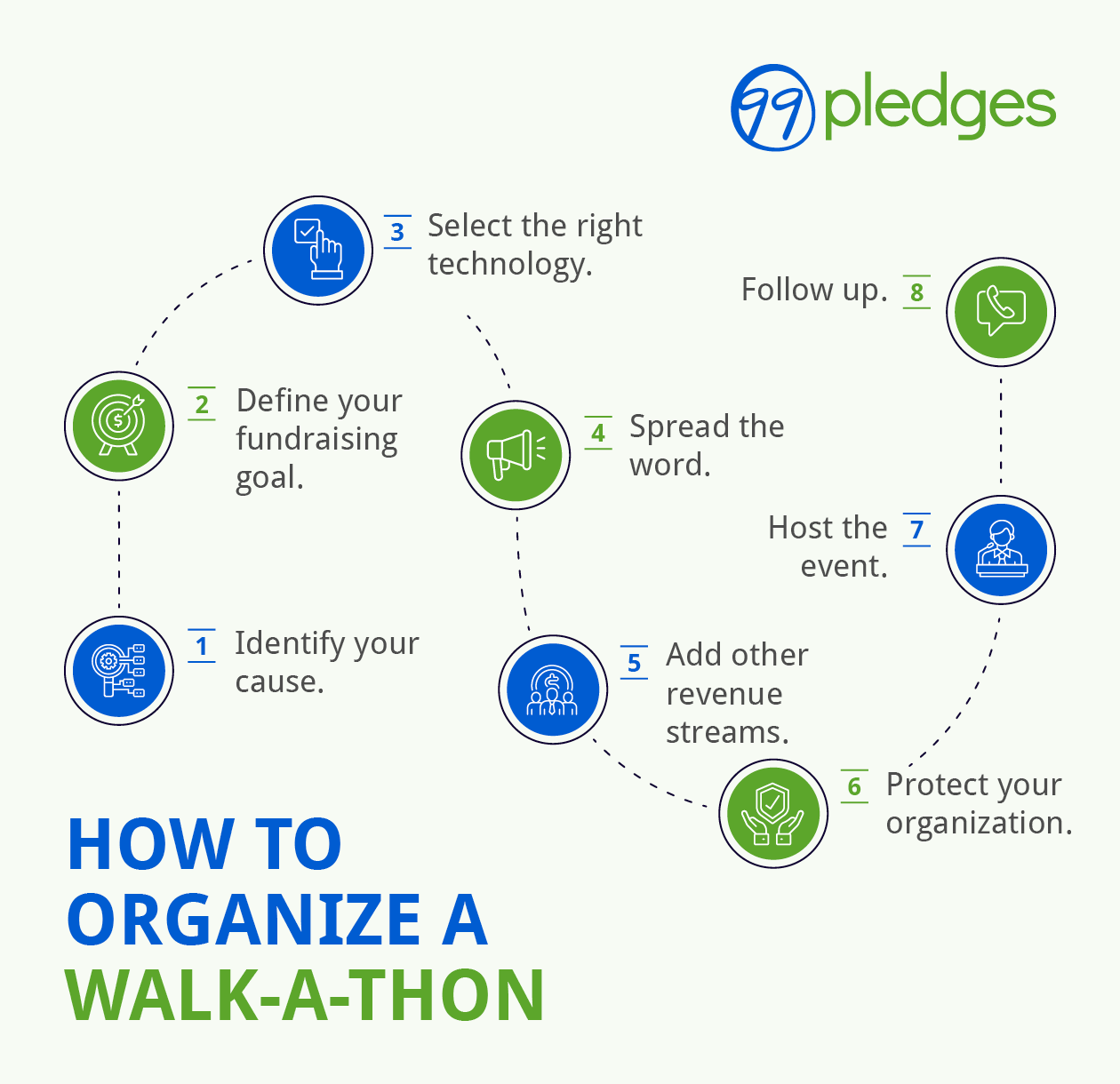
1. Identify your cause.
Because fundraising walks conclude with an event, they are time-bound fundraisers. Use this deadline—along with details about the specific project or need the funding will assist with—to inspire a sense of urgency among your supporters.
For example, perhaps your school needs to raise enough money for students to go on a field trip in two months. Or, maybe your animal shelter needs to buy new kennels before kitten season starts to house all of the animals in need.
To help participants structure their communications with potential donors, determine the exact cause for which you’re raising money: textbooks and school supplies, an upcoming trip to a competition, an outdoor expedition, or a new youth group program, for example. This will give your campaign a more unified feel and help participants effectively convince their friends and families to give.
2. Define your goal.
Determine how much your participants need to raise to fund your project, and share this goal across donation pages and various marketing messages. Including this on your participants’ fundraising pages can incentivize supporters to give more, bringing you closer to your goal.
You might also set small goals or incentives for each donor or participant. For example, if a donor pledges $50, they’ll receive a custom race t-shirt. Or, if they refer at least three other donors to help an individual participant meet their goals, they’ll get a shirt. Tie these incentives back to your overall goal and how the funding will benefit your cause.
As the organizer, use your Walk-a-thon fundraising software to track your participants’ progress toward this goal, perhaps even encouraging competition among individuals or groups to see who can raise the most donations! For example, a school might offer a pizza party to the classroom that raises the most money.
3. Select the right software.
Your fundraising walks will be easier and more successful when you collect pledges and donations using Walk-a-thon fundraising software. A provider like 99Pledges can get you started by automatically creating pages for each participant that they can share online.
Your provider will email each participant a link to their individual page, which they can then share via Facebook, Twitter, email, and text—no additional set-up or tech experience required! When your fundraiser has concluded, your provider will send your organization a check for the total amount you raised in donations. Plus, 99Pledges makes giving easy for your supporters by accepting various payment methods, including credit and debit cards, PayPal, GooglePay, and ApplePay.
Additionally, choose a solution that is flexible enough to facilitate or promote other campaigns. For instance, maybe you are selling commemorative Walk-a-thon merchandise ahead of the event—99Pledges will allow you to add a link to purchase the shirt to your donation page.
4. Spread the word.
Your Walk-a-thon fundraising software makes it easy to collect pledges and donations. However, your participants are still responsible for sharing the pages with their networks of friends, family, social media followers, and other connections to ensure your fundraiser’s success!
If you’re working with a group of students who are doing the fundraising themselves, encourage creative thinking and teamwork by brainstorming innovative ways to share the pages, reach new audiences, and express your organization’s goals most effectively. Consider putting together creative assets and templates like custom graphics and social media captions for the Walk-a-thon that students can use to share the fundraiser.
5. Add other revenue streams.
While events like Walk-a-thons are exciting and can be highly profitable, they do come at a cost. Specifically, organizations will need to pay for a venue, catering, entertainment, decor, equipment rentals, and more—and that’s not to mention the hours of staff and volunteer time that goes into planning and executing your event.
Because events can be resource-intensive, it’s a good idea to supplement pledged gifts and peer-to-peer revenue with other funding sources, namely merchandise. You might offer custom school spirit t-shirts, tote bags, mugs, notebooks, and more. Commemorative gear that features the name and year of the event makes a great souvenir for participants.
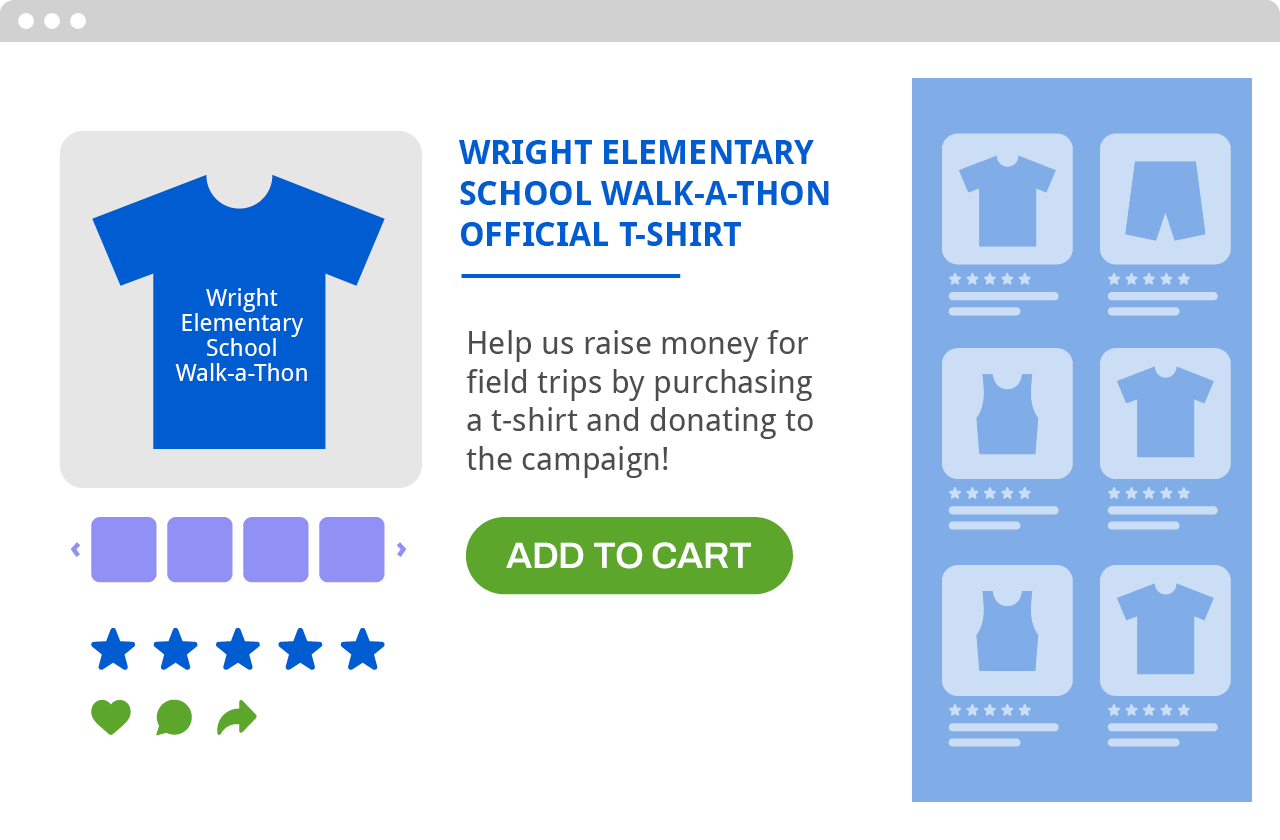
Here are some ways to infuse t-shirt merchandise sales into your walk-a-thon:
- Offer or sell custom t-shirts to your walk for a cause participants.
- Award each donor with a t-shirt as an incentive to give.
- Set up a merch stand or booth at the finish line for spectators and participants.
- Sell custom merchandise online ahead of the race.
- Hold a t-shirt designing contest and sell the winning design.
- Collaborate with event sponsors to create and sell co-branded merchandise.
You can bring in additional revenue by organizing a concessions stand, soliciting sponsorships from local businesses, holding raffles or games, or featuring popular activities like a photo booth.
If you choose to offer merchandise, remember to launch this fundraiser on a reputable platform. Ideally, the platform should be free to use and create shirts for you. The best platforms will also process, sell, and ship orders for you so your school doesn’t have to hold inventory. Avoiding monthly subscriptions, high upfront costs, and inventory costs will help you maximize your investment and see the highest fundraising ROI possible.
6. Protect your organization from liability.
As with any physical activity, participating in a Walk-a-thon fundraiser carries some level of risk. Use digital waiver software to ensure your organization is covered if someone does get hurt. Work with a lawyer to draft the waiver, format it in a customizable digital waiver template, and share it online!
Because participants (or their guardians) can submit the waiver ahead of time, you’ll avoid check-in desk lines and chaos with an online solution.
7. Host the event.
Your participants should feel motivated and accomplished when the time comes to complete their walk. Before the event, make sure to:
- Plan logistical details. Select a date, time, and location for your start and finish lines. Avoid dates that are likely to be particularly hot, cold, or rainy. Spring and fall are ideal times!
- Chart the perfect route. Plan the route your walkers will take, keeping distance, elevation, and terrain in mind. Walk-a-thons are typically 5K or 10K, but you can adjust the distance based on your participants’ average age and ability.
- Obtain any necessary permits or licenses. Do your research to see what kind of permits or insurance you need to obtain to hold the event. Additionally, reach out to your town or city to let them know where the race is taking place—they may advise that you work with police to direct traffic or paramedics to run a medical tent.
- Sell spectator tickets. Charging a small entry fee to Walk-a-thon onlookers is a great way to drive additional revenue without much effort. Offer tickets online and set up a booth at the starting line for in-person sales.
Remember to spread the word about your event to attract plenty of attendees who will cheer on participants. Share information about the event on social media, via email, and even with flyers around your community.
8. Follow up.
After your fundraising walk, lay the groundwork for a strong and sustainable relationship with the supporters who contributed to your cause. In the days following your event, make sure you’re practicing good stewardship by:
- Thanking your participants via email and text message. If they went above and beyond for your cause, consider sending a handwritten note.
- Sending pledge reminders if you collected pledges ahead of the event. People are busy, and they’ll appreciate being reminded if they’ve forgotten!
- Sharing other ways donors can get involved. Donors can provide so many additional benefits to your organization besides financial support. Keep them updated on volunteer opportunities, matching gift opportunities, and in-kind donation needs.
Hosting a successful Walk-a-thon fundraiser is an achievement that everyone—including organizers, participants, and supporters—deserves to be proud of. However, raising a lot in donations and hosting a fun event doesn’t have to be difficult.
With teamwork, generosity, and a little help from the right fundraising platforms, your Walk-a-thon fundraiser will help you reach your funding goals.
Wrapping Up
Walk-a-thons are the perfect fundraisers to leverage the popularity of online giving, promote leadership and teamwork, and motivate young people to work toward a good cause.
Using robust fundraising software will help you manage the behind-the-scenes details seamlessly, providing great experiences to supporters and maximizing your profits. Plus, fundraising sites that facilitate additional fundraisers in tandem with your Walk-a-thon—like custom t-shirt sales—will make the campaign a bigger success without taking up hours of your time.
Check out the following additional resources to help make your Walk-a-thon a success!
- 20+ Amazing PTA Fundraising Ideas for Every Occasion. If your organization loves the walk for a cause format but wants to change the event type to better reflect your activities, take a look at this list of a-thon-style fundraisers that follow the pledge model.
- 40 Nonprofit Fundraising Event Ideas Communities Will Love. Looking for more events similar to a Walk-a-thon that can engage your community? Explore this guide and reach new audiences of enthusiastic supporters.
- The 20 Best Online Donation Tools. Walk-a-thon software designed to help your organization collect pledges and donations can help ensure the success of your event. Find the right tools using Double the Donation’s list.


